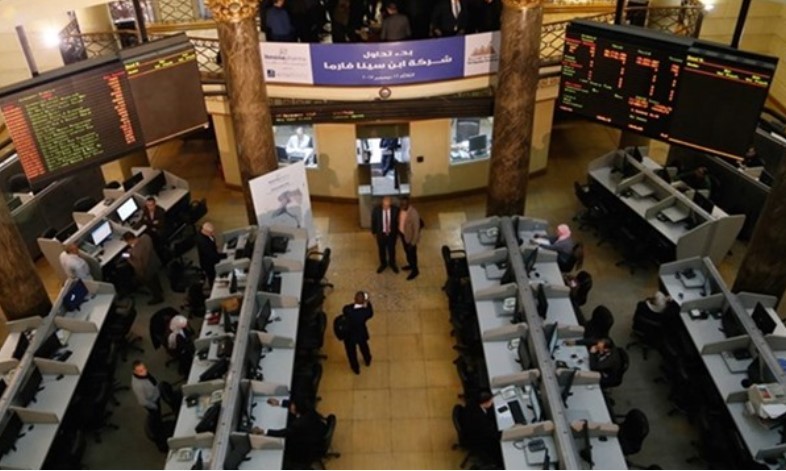Top 10 Largest & Wonderful Pyramids In The World
 |
| Largest and most beautiful Pyramids in the World. Photo: knowinsiders. |
| Table Content |
What are the largest and most beautiful pyramids in the world?
Used as temples or tombs, pyramids are some of the ancient world’s largest structures. Truly, they’re feats of human ingenuity and engineering. For many people, Egypt or the Americas is where they think the largest pyramid in the world can be found. However, the picture changes when we consider modern-day pyramid-style buildings. Let's explore our top 10 largest and the most beautiful ones in the world:
1. Ryugyong Hotel, North Korea
2. The Shard, London, UK
3. Transamerica Pyramid, San Francisco, USA
4. The Great Pyramid Of Giza, Egypt
5. Pyramid Of Khafre, Egypt
6. Luxor, Las Vegas, USA
7. Bent Pyramid, Egypt
8. Red Pyramid Of Dahshur, Egypt
9. Memphis Pyramid, USA
10. La Danta Pyramid, Guatemala
1. Ryugyong Hotel, North Korea
In 1987, ground was broken on a grand new hotel in North Korea's capital, Pyongyang. The pyramid-shaped, supertall skyscraper was to exceed 1,000 feet in height, and was designed to house at least 3,000 rooms, as well as five revolving restaurants with panoramic views.
The Ryugyong Hotel -- named after a historical moniker for Pyongyang meaning "capital of willows" -- was supposed to open just two years later. But it never did.
While the structure reached its planned height in 1992, it stood windowless and hollow for another 16 years, its naked concrete exposed, like a menacing monster overlooking the city. During that time the building, which dwarfs everything around it, earned itself the nickname "Hotel of Doom."
The hotel has since been clad in metal and glass, and was later fitted with LED lights to turn it into a colorful nighttime spectacle. Construction work has started and stopped many times, fueling constant speculation over whether it will ever open to guests.
The building consists of three wings, each sloped at a 75-degree angle, converging into a cone encasing the top 15 floors, which are intended for restaurants and observation decks.
The pyramidal shape is about more than aesthetics -- it's because the Ryugyong, unusually for a skyscraper, is made of reinforced concrete rather than steel.
"It was built like this because the upper levels needed to be lighter," said Calvin Chua, a Singapore-based architect who has extensively researched Pyongyang's urbanism, in a phone interview. "They didn't have advanced construction materials, so it was built entirely in concrete. You can't achieve a slender tower that way, you need to have a massive base with a tapered top.
| The original plan was for a mixed-use development. This included a huge hotel and revolving restaurants. Another interesting fact: the building’s pyramidal shape isn’t all about aesthetics. Rather than steel, reinforced concrete is the hotel’s main building material. Because the upper levels needed to be lighter, they had to taper to a point. Hence the building’s pyramid-like appearance. Still closed to this day, the Ryugyong Hotel is the world's tallest unoccupied building. |
 |
| Ryugyong Hotel, Pyongyang, North Korea – by Torsten Pursche / Shutterstock.com |
2. The Shard, London, UK
The Shard, also called the Shard of Glass, is a 95-storey skyscraper in London. It stands above London Bridge Station on the South bank of the River Thames. The building houses offices, restaurants, a hotel and the highest public viewing platform in Britain on the 72nd floor. It features a 26 floor office complex.
Italian architect Renzi Piano came up with the design, meant to resemble a jagged glass sculpture rising from the river. Building began in March 2009 and the structure was finished in November 2012.
In February 2011, an intrepid fox was found living off builders' scraps 945ft up the half-finished tower. The observation deck on the 72nd floor opened to the public in February 2013. The Shard won first place in the 2013 Emporis Skyscraper Awards, which was won by Norman Foster's Gherkin ten years earlier.
At 1,016ft (310m), The Shard is the tallest building in Britain and the European Union, and 96th tallest in the world. It is eight feet shorter than the Eiffel Tower, although that does NOT count as a building as it is not habitable. And it is not the tallest structure in Britain - which is the 1,084ft (330m) Emley Moor transmitting station in West Yorkshire. Britain's previous tallest building was One Canada Square in Canary Wharf, East London, which stands at 770ft (235m).
The Shard was briefly the tallest building in the continent of Europe until it was surpassed by the 1,112ft (339m) Mercury City Tower in Moscow. The Federation Tower, also in Moscow, is now the tallest at 1,226ft (374m). The tallest building in the world, the Burj Khalifa Tower in Dubai, is more than twice as high as The Shard at 2,717ft (828m).
 |
| The Shard, London, UK – by digital341 / Pixabay.com |
| The Shard houses the five star Shangri-La hotel on floors 34 to 52. It also has a range of bars and restaurants boasting views high above the city. Aqua Shard offers "innovative contemporary British cuisine" on the 31st floor. On the floor above there is "sophisticated urban casual dining" at Oblix. Hutong, on floor 33, is based on a Hong Kong restaurant of the same name. Gong, on floor 52, claims to be the highest hotel bar in Western Europe. There is also the cafe and wine bar Lang at the foot of the tower next to the train station. |
3. Transamerica Pyramid, San Francisco, USA
The Transamerica Pyramid is located in San Francisco’s financial district and just a stone’s throw away from San Francisco’s historic Chinatown. The looming landmark features a white quartz exterior and more than 3,000 windows. It is also built to withstand tremors and sustained no damage or injuries during the 1989 Loma Prieta earthquake. At 853 feet, The Transamerica Pyramid is the tallest point in San Francisco, California.
The site of the Transamerica Pyramid was originally known as Montgomery Block, a historic building that housed lawyers, financiers, writers, actors and artists from 1853 to 1959. After being torn down in the 1930’s, the block became a parking lot for most of the 50’s and 60’s, prior to construction beginning in 1969.
Constructed in 1972, the Transamerica Building was originally met by public outcry and residents claiming that San Francisco was no place for an ‘obelisk-shaped skyscraper.‘ Its unique shape was actually built for environmental practicality in order to let natural light and airflow reach the already crowded streets of San Francisco.
Before cement streets and skyscrapers sprung up, San Francisco’s natural waterfront was located mere feet from Montgomery Street, where ships docked at wooden boardwalks. The remains of sunken ships had to be dug up in preparation to lay the foundation for the Transamerica Pyramid. Today, the building stands as a symbol of pride for the city and an undeniably characteristic part of San Francisco.
Originally built for the Transamerica Corporation, the building was bought out in 1999 by Aegon, a Dutch insurance company, and currently serves as office space for financial and insurance services. At the top of the 48 floors of office space and conference rooms rests the 212-foot tall spire, which is topped off by the ‘crown jewel’, a beacon of light that can be seen through San Francisco on special occasions.
 |
| The Transamerica Pyramid building has been a mainstay of the San Francisco skyline since its 1972 opening. (CoStar) |
| Though the spire of the building and the panoramic-view conference room are not available to the general public, a small park at the base of the building offers a picturesque view of the building and a quiet space for pedestrians to visit. Despite original protests against the building’s construction, it has become not only one of the most photographed buildings in the world, but also an undeniably important part of San Francisco’s history and culture. San Francisco would not be the same without the majestic presence of the Transamerica Pyramid. |
4. The Great Pyramid Of Giza, Egypt
The Great Pyramid Of Giza is the oldest and largest between the 3 pyramids of Giza. It is also the oldest and the only still standing structure of the Seven Wonders of the Ancient World. The Great Pyramid was built around 2560 – 2540 BC, with a height of 146.5 metres (481 ft). The Pyramids of Giza are listed as cultural world heritage site.
The largest pyramid in Giza, and in the world, belongs to the second king of the Fourth Dynasty, Khufu or “Cheop”. Khufu’s pyramid is Giza’s oldest and, at its great size of 145 metres, became known as “The Great Pyramid”. In fact, Khufu’s pyramid was once the tallest structure in the world as well as being one of the Seven Wonders of the World. A UNESCO World Heritage site, Giza is also where one finds the Great Sphinx. Estimated to date back to 2528–2520 BC, some Egyptologists believe that this majestic half man, half lion is modelled on Khafra.
It originally had a smooth, white limestone covering that reflected sunlight or moonlight. Inside, the King’s Chamber holds a large granite sarcophagus. The Giza complex also includes mortuary temples, pyramids for Khufu’s wives, and mastaba tombs for the nobility. To further learn about Giza’s wonders, check out this private half-day tour.
Egyptologists are still not quite sure how the pyramids were built, but the most widely believed theory is that the Egyptian people all helped construct the buildings as an act of civil service. These builders were skilled laborers who were paid for their work. The discovery of a village located near the pyramids has led archaeologists and Egyptologists to believe that, at the peak, around 20,000 Egyptians were working to construct the pyramids.
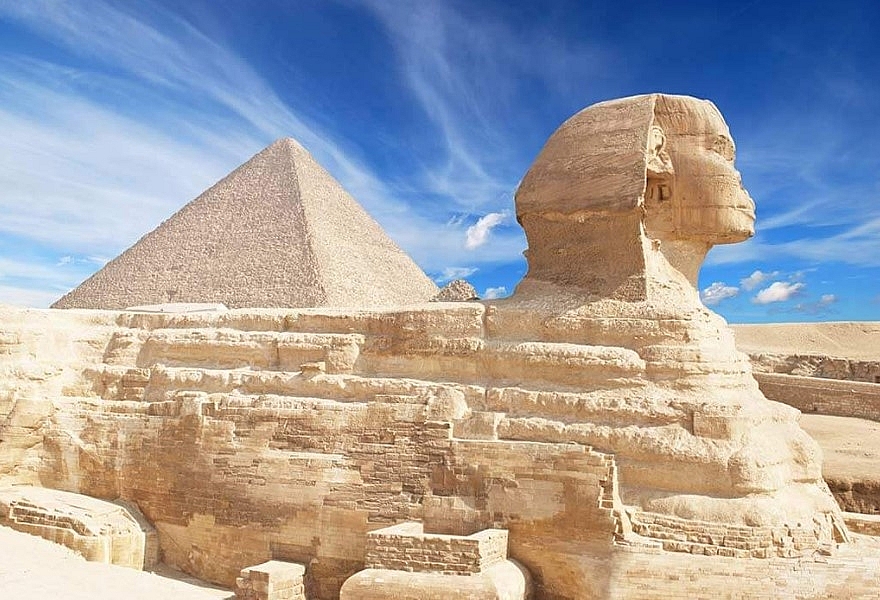 |
| The Sphinx & The Great Pyramid of Giza, Egypt / Shutterstock.com. |
One of the most impressive Great Pyramid of Giza facts is that each of the limestone blocks used to build the pyramid weighs two tons, which is about the same weight as a midsize SUV. How exactly the locals were able to lift those stones and form the perfect pyramid is up for debate. Some scholars say the Egyptians used a ramp and pulley system.
| The Great Pyramid of Giza was the tallest building in the world for 3,800 years! The Lincoln Cathedral in Lincoln, England, which was completed in 1311, was the first building to surpass the height of the Great Pyramid. |
5. Pyramid Of Khafre, Egypt
The Pyramid of Khafre is the second largest pyramid at Giza, after the Great Pyramid built by Khafre’s father Khufu. It appears to be slightly larger however as it is build at a higher elevation. The pyramid has a base length of 215.5 meter (706 ft) and originally rose to a height of 143.5 meter (471 ft) but is now 12 meters shorter. The most distinctive feature of Khafre’s Pyramid is the topmost layer of smooth stones that are the only remaining casing stones on a Giza Pyramid.
The interior is much simpler than that of Khufu’s pyramid, with a single burial chamber, one small subsidiary chamber, and two passageways. The mortuary temple at the pyramid base was more complex than that of Khufu and was filled with statuary of the king—over 52 life-size or larger images originally filled the structure.
Khafre’s valley temple, located at the east end of the causeway leading from the pyramid base, is beautifully preserved. It was constructed of megalithic blocks sheathed with granite and floors of polished white calcite. During excavation, a magnificent just over life size statue of the king carved of an extremely hard stone known as gneiss was discovered buried under the floor of the Valley Temple. This sculpture shows the king seated on a lion throne that has on its sides a symbol of the two heraldic plants of Upper and Lower Egypt, the papyrus and lotus, bound around a hieroglyph for “stability.” This important emblem, known as a sema-tawy (“binding the Two Lands”), represents the king’s primary duty—to “bind” the country under the authority of a single ruler. The king is supported in his task by the Horus falcon that wraps protectively around the back of his nemes headdress. Statue bases and other fragments indicate that this was one of about 23 such images of the pharaoh that were originally located in this temple.
| Khafre (c.2558–2532 BC), whom the ancient Greeks knew as Khefren, was a son of King Khufu (Cheops), the builder of the Great Pyramid. He built the second pyramid complex at Giza, and constructed his tomb on slightly higher ground, making it appear just as tall as his father’s. At 143.5 meters in height, however, his pyramid is only slightly shorter, and a tremendously impressive monument. Its core masonry is made of blocks of local limestone. The top of the pyramid still preserves the beautifully polished blocks of high-quality limestone that once encased the majority of the structure’s towering height. This white stone was quarried in Tura, south of Maadi, and transported here by ship. |
The mortuary temple of Khafre at the foot of his pyramid and the valley temple at the end of the causeway are larger than any of those of older pyramids, and also among the best preserved of the Old Kingdom. Another development in the reign of Khafre is the complexity of their layout, with the elements constituting his mortuary temple becoming the new standard that its later Old Kingdom counterparts would follow.
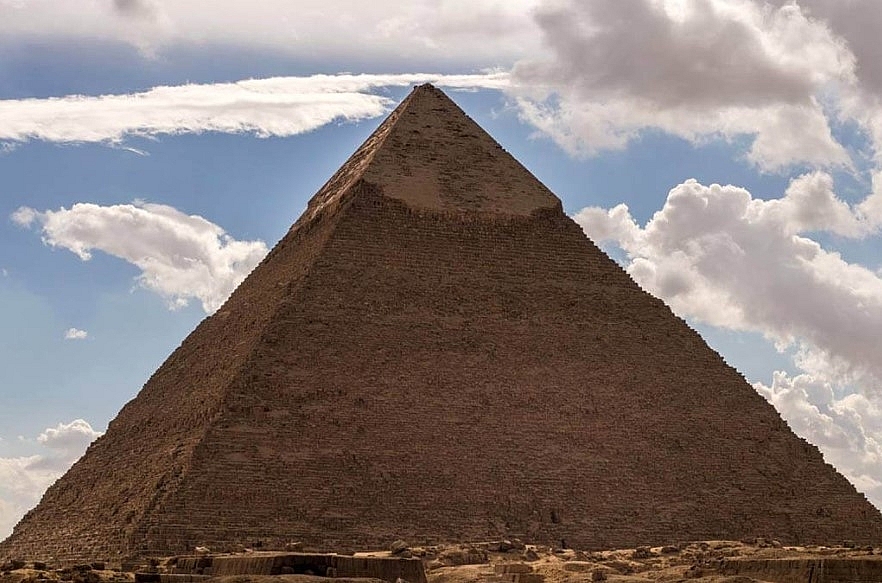 |
| Pyramid Of Khafre, Egypt / pxhere.com |
A unique feature of Khafre’s complex is the inclusion of a colossal statue beside his valley temple—the Great Sphinx. The valley temple is made of massive limestone blocks encased in granite, floors made of alabaster, and its wide hall features monolithic granite pillars. The symmetrically arranged niches along the walls of the hall once accommodated statues of the king, some of which are currently on display in the Egyptian Museum. One of these, the famous granodiorite statue of Khafre with Horus as a falcon perched behind his head, is widely considered one of the masterpieces of ancient Egyptian art.
6. Luxor, Las Vegas, USA
The Las Vegas Strip is one of the top tourist attractions in the USA. Since 1993, it’s also been the home of Luxor Las Vegas, a 30-story hotel and casino. Owned and operated by MGM Resorts International, it was the Strip’s tallest building when it opened. Today, it’s one of the largest pyramids in the modern world.
The Luxor Pyramid was among the first of a decade-long wave of new megaresorts to emerge on the Las Vegas Strip in the 1990s. Opened in 1993 after only eighteen months of construction, the Luxor debuted with 2,526 guest rooms, a gigantic casino area, a showroom, restaurants, and entertainment venues on its 2nd floor. At a base length of 183 meters (600 ft) and a height of 110 meters (350 ft) it is considerably smaller than its famous model, the Great Pyramid at Giza.
The Luxor takes its name from the ancient Egyptian city of Thebes. It boasts 4,400 guestrooms, a huge casino, eight restaurants, and four outdoor pools. It also has the world’s largest atrium. Moreover, the hotel features the world’s strongest light beam: the Luxor Sky Beam. And when it comes to shows, the Luxor offers plenty. These include concerts and revues headlined by the biggest names in showbiz.
| It may not be ancient, but the Luxor is technically as much a pyramid as any found in Mexico or Egypt. The Luxor pyramid is, in fact, one of the largest pyramids in the United States and one of the tallest in the world. At around 350ft (107m) tall, it’s dwarfed only by two of the pyramids in Giza, Egypt. |
You can enter the Atrium through a replica of the Great Sphinx at Giza that covers a moving walkway leading from the Strip into the Atrium. The Sphinx in Las Vegas is 110ft (34m) high, more than 40ft (12m) taller than its antique counterpart in Egypt, making it a popular place for people looking to snap a selfie or two. To get the ultimate selfie with the Sphinx in the foreground and the black Luxor in the back, make sure you go in the morning.
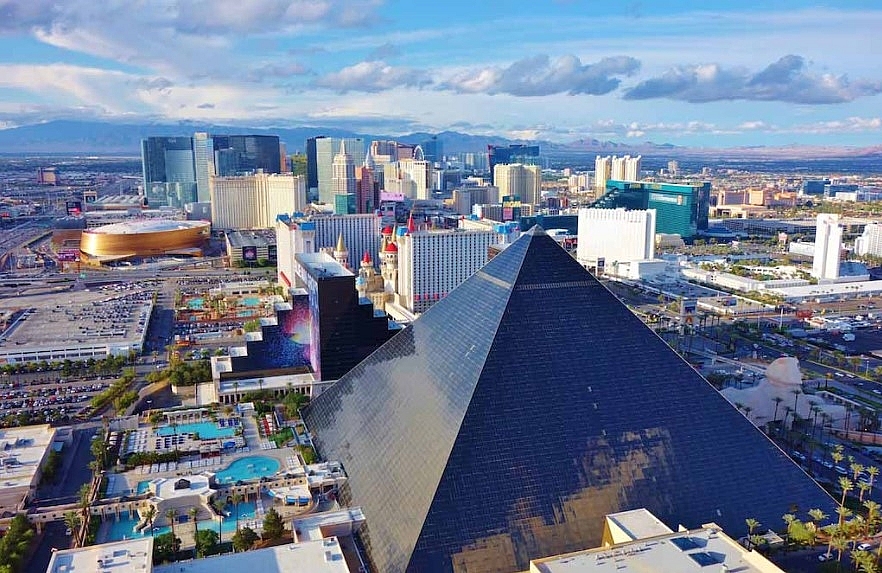 |
| Luxor Pyramid, Las Vegas, USA – by EQRoy / Shutterstock.com. |
7. Bent Pyramid, Egypt
The Bent Pyramid at Dahshur was built during the end of 27th century BC by Sneferu, the father of Khufu, who built the Great Pyramid at Giza. It is an important stepping stone in the development of pyramid construction. Sneferu built more than one pyramid at Dashur, but the Bent Pyramid was the first.
This was the second attempt by Sneferu to build a smooth-sided true pyramid. It is believed that the first attempt, at Meidum in Fayoum, collapsed during construction. This second attempt was also plagued by engineering issues, although it was eventually completed. Sneferu’s builders were still learning and planned to built the huge structure with a steep inclination 54 degrees on each side. This proved unstable and caused them to abruptly change the plan in the middle of construction. The Bent Pyramid gets its name from the fact that the angle of its sides shifts suddenly about one-third of the way up from 54 degrees to the more gentle slope of 43 degrees. For this reason, the Bent Pyramid is considered a transitional pyramid, rather than a true pyramid.
Despite this engineering mistake, the Bent Pyramid remains an impressive site. It is 332 feet tall and it is unique among all of the pyramids in Egypt in that much of its limestone casing remains intact so that visitors can get an impression of what all of the pyramids were intended to look like before these outer stones fell off or were taken for other construction projects.
The Bent Pyramid has not been accessible to the public since 1965, as Live Science’s Laura Geggel reports. During the intervening decades, the 331-foot-tall structure underwent much-needed restoration work; experts fixed up internal and external stairs, added a lighting network and repaired stone work in the corridors and chambers. Thanks to their efforts, tourists can now enter a raised entrance on the newly reopened pyramid’s northern side, climb down an 86-yard tunnel and explore two chambers, according to Reuters’ Aidan Lewis.
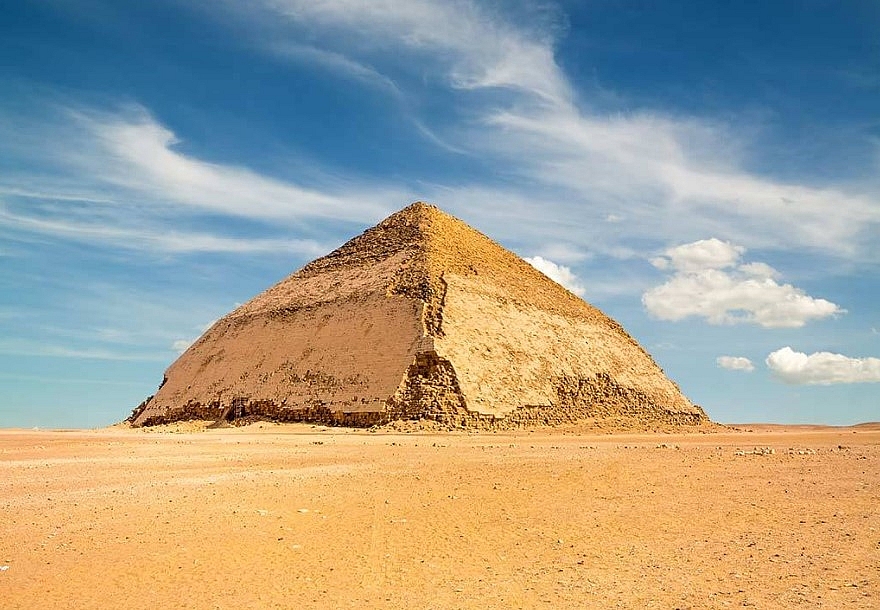 |
| Bent Pyramid, Egypt / Shutterstock.com |
| The Bent Pyramid was an experiment of sorts for Sneferu, a pharaoh of the Old Kingdom of Egypt. It was his second pyramid after the one in Meidum. The pyramid’s name comes from its top section, which appears bent because of its shallow angle. It’s possible that the original angle was too steep, forcing the builders to compensate to prevent the pyramid from collapsing. Closed to tourism since 1965, the Bent Pyramid re-opened to visitors in 2019. Tourists can access the side pyramid. It opened to the public for the first time since its 1956 excavation. Some archaeologists believe that this side pyramid was intended for Sneferu’s wife, Hetepheres. |
8. Red Pyramid Of Dahshur, Egypt
After the Great Pyramid of Khufu at Giza, the Red Pyramid at Dashur has the largest base (only slightly smaller than Khufu's pyramid, each side measures 722 feet) of any pyramid in Egypt. However, with it's sides sloping at 43 degrees 22', it is substantially shorter at 343 feet (104 meters). It is the fourth highest pyramid ever built in Egypt, with almost 160 layers of stone. Significantly, the Red Pyramid was the first successful, true, cased Pyramid built in Egypt, ushering in the era of the Giza style pyramids.
The Red Pyramid was another project of the 4th Dynasty pharaoh Sneferu. After the completion of the Bent Pyramid, which also stand nearby in the Necropolis at Dahshur, Sneferu set out to correct the mistakes that were made in the construction of his that pyramid and the one at Meidum that collapsed during construction.
The Red Pyramid, finished sometime at the beginning of the 26th century BC, was to be first successful attempt to construct a true pyramid, making it the most direct inspiration for the later 4th Dynasty pyramids at Giza.
The squat appearance of this pyramid in comparison to other pyramids of comparable size is due to the fact that its sides are included at the relatively shallow angle of 43 degrees. After the engineering mistake that led to the ‘bend’ in the Bent Pyramid, Sneferu’s builders presumably decided to build this pyramid using the same angle of inclination that had allowed for the completion of the Bent Pyramid. The Red Pyramid 341 feet tall.
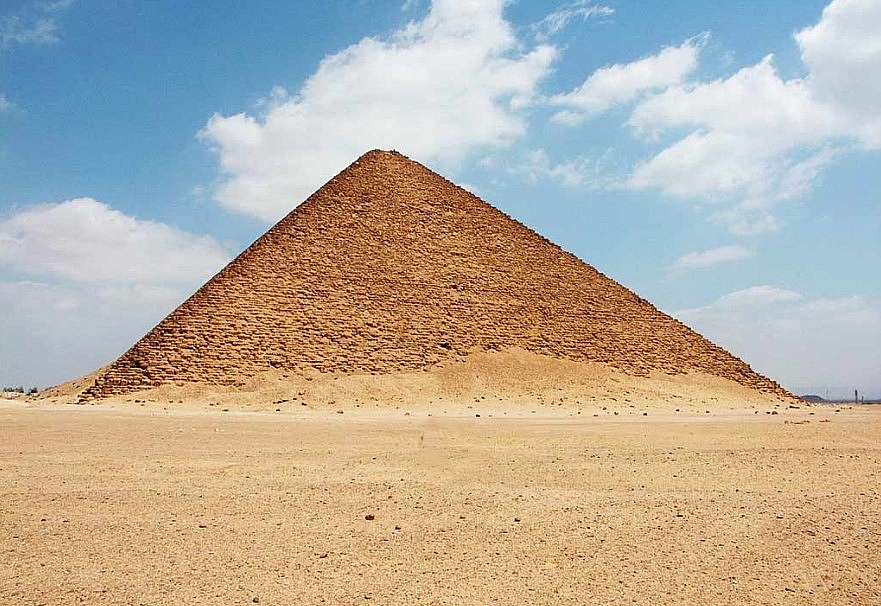 |
| Red Pyramid Of Dahshur, Egypt – by lienyuan lee / Wikimedia Commons |
| Located at a short distance from Saqqara, the Red Pyramid at Dahshur was built for the pharaoh Snefru, father of Khufu for whom the Great Pyramid of Giza was built. The Red Pyramid is the first 'true' pyramid and it has the second largest base of all Egyptian pyramids. What makes it yet more interesting is that it can be fully accessed, including the chance to see the burial chamber. There's something special about exploring the cold and silent passageways inside the pyramid. Do not go inside if you are not comfortable in enclosed space. |
Perhaps greater importance is the fact that some of the casing was dated. This not only gives us clues to how long the pyramid took to build, but also the sequence of work that took place. From these, we know that the pyramid was probably begun between the twenty-second and twenty ninth year of Snefru's reign. Other dates tell us that two years later, six layers of stone had been laid. However, within four years, 30 percent of the pyramid had been completed, and the entire pyramid was finished in about seventeen years.
9. Memphis Pyramid, USA
It is one of the largest pyramids in the northern hemisphere. It has been called the “Tomb of Doom” and is rumored to have been cursed by the removal of a crystal skull. It’s also a Bass Pro Shop, and it’s located in Memphis, Tennessee.
All of these are true facts about the so-called “Memphis Pyramid,” one of the most peculiar modern landmarks in America, and a building with a history that is stranger than fiction.
Originally conceived of by Mark C. Hartz in 1954, the “Great American Pyramid” was once going to be a complex involving three pyramids on the banks of the Mississippi River. As a nod to the city’s namesake, the Memphis pyramids were to be built as two-thirds scale replicas of the famous Pyramids of Giza, located near the ancient city of Memphis in Egypt.
Built on the Giza Plateau during Ancient Egypt’s Fourth Dynasty, which lasted from circa 2613 BCE to 2492 BCE—more than four thousand years ago—the Great Pyramids of Giza are one of the Seven Wonders of the Ancient World. The pyramid complex includes three large pyramids—the Pyramid of Khufu, also known as the Great Pyramid, the Pyramid of Khafre, and the Pyramid of Menkaure—not to mention the three smaller Pyramids of Queens as well as various graveyards, tombs, temples, worker villages, and, of course, the Great Sphinx.
Today, the pyramids are striking for how they stand separate. While there is city all around, the pyramids themselves are on their own island of sand, not far from Cairo and the banks of the Nile. When they were built, however, the ancient city of Memphis, which was once the capital of Egypt for hundreds of years, was just a few miles away.
Today, the ruins of ancient Memphis lie buried beneath the sands or excavated via archaeological expeditions. The nearest inhabited town is Mit Rahina, home to a massive open-air museum built around the fallen statue of Ramses II that once stood near the temple of Ptah in the city of Memphis.
As famous as the great city itself are the city’s necropolises and the numerous pyramids that surround the ruins of the ancient city. These tombs and pyramids have been studied by archaeologists since the early 19th century. Some of the earliest excavations were conducted by Giovanni Caviglia and Charles Sloane, who was then the British Consul in Cairo. They discovered the statue of Ramses II and, with it, the ruins of ancient Memphis.
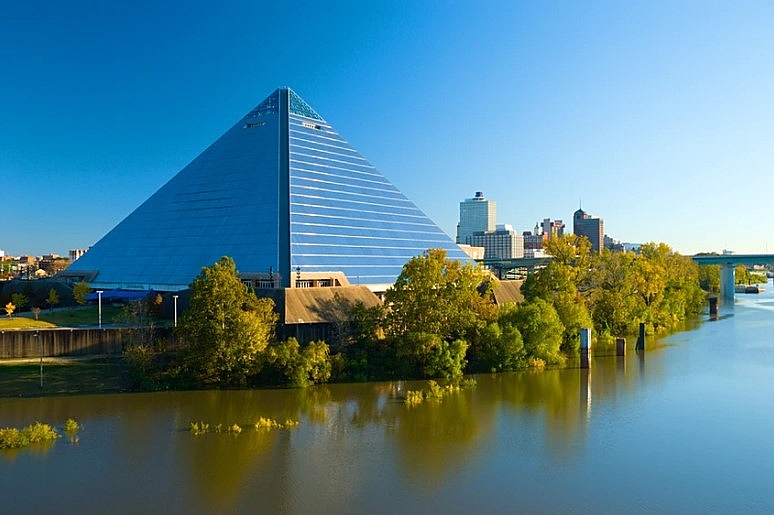 |
| The Memphis Pyramid is an unusual landmark on the city's skyline, but its history is even more interesting. Davel5957 Getty Images/iStockphoto |
But the pyramid was plagued with problems from before it even opened its doors. A torrential rain storm delayed construction and plans for shops and amenities in the structure fell through, including a music museum, a shortwave radio station, a nearby theme park, and a Hard Rock café.
When the Memphis Pyramid did finally open its doors in 1991, its grand opening was a concert by country duo the Judds. Unfortunately, when a packed house all poured into the restrooms at the same time, the combined stresses of all those flushing toilets proved too much for the city’s sewer transfer station. The toilets backed up, flooding the arena with sewage. It seemed that the Memphis Pyramid was off to a less-than-auspicious start.
| The city government signed a 55-year lease agreement with Bass Pro Shops. As a result, the Memphis Pyramid became a Bass Pro Shops megastore in 2015. Besides the huge retail store, there are other attractions. These include a shooting range, an archery range, and a laser arcade. The building also boasts the country’s tallest freestanding elevator. |
10. La Danta Pyramid, Guatemala
Hidden in the dense northern Guatemala jungle is the largest pyramid in the world of the Mayans. Aside from its impressive height, La Danta boasts a volume of almost 3 million cubic meters (99 million cubic feet). Likewise mind-boggling is the thought that it took millions of days of labor to build it.
La Danta lies in the ancient Mayan settlement called El Mirador. It’s located in El Petén. This is about 68 km (42.2 mi) from the Guatemalan city of Flores. El Mirador prospered from 6 BC to 1 AD. However, by the end of the 9th century, it had been abandoned. Two other pyramids are also in El Mirador: El Tigre and Los Monos. If you’re fit and keen for a hike, you might enjoy the Mirador Quest Trek. This expedition will reward you with stunning views from the top of La Danta.
Visitors to the site can climb La Danta and look out over the surrounding jungle, which stretches as far as the eye can see in every direction. It’s a magical place, and one that has so far been protected by its remote location.
You can visit El Mirador on a five-day trek from the village of Carmelitas, itself a three-hour drive from the tourist hub of Flores. It’s easy to book tours in town. Be prepared for a grueling walk through hot, wet jungle. You will sleep in tents along the way, and most likely be woken up by howler monkeys in the mornings!
The history of El Mirador is complicated, with periods of rapid growth, abandonment, and re-population. Between 300BC and 100AD the city was at its largest, with a population of 100-250,000 people living in an area of 10 square miles.
A unique agricultural system sustained the city and allowed it to grow, but the most impressive structures are the temples. Chief among them is La Danta, the largest pyramid in the world by volume. It is so well aligned with other buildings in the city that archaeologists believe the entire settlement was planned before construction started, following solar alignments.
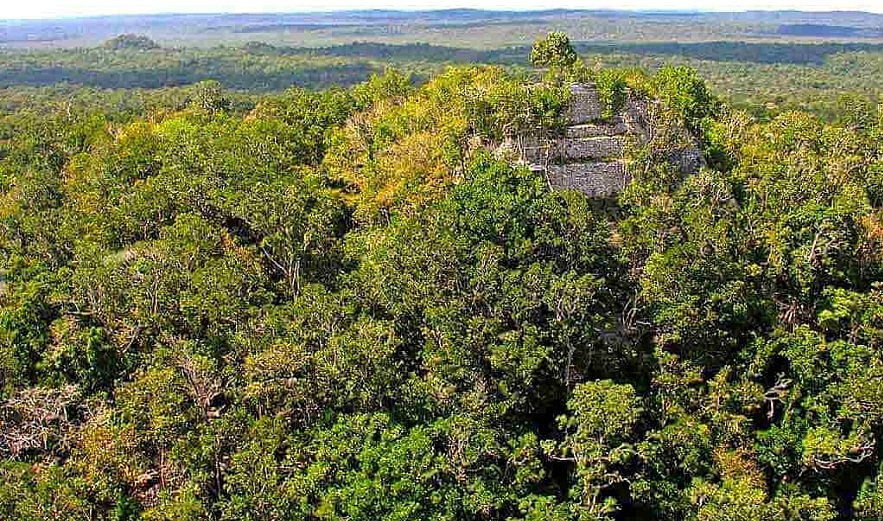 |
| La Danta Pyramid at El Mirador, Guatemala – by Dennis Jarvis / Wikimedia Commons |
 Top 10 Largest Shopping Malls in UK Today Top 10 Largest Shopping Malls in UK Today If shopping is your kind of game, you are definitely spoilt for choice in the UK. Check out the list of 10 largest shopping malls ... |
 Top 10 Most Popular Cars in America and Every State 2021/2022 Top 10 Most Popular Cars in America and Every State 2021/2022 Which cars have Americans loved to drive the most this year and next year? Check out the top popular cars in the US and every ... |
 Top 10 Most Famous Temples in England Top 10 Most Famous Temples in England Let's explore these 10 most famous temples in England that you can visit in the article below. |

